the history of yeovil's pubs
PUBS HOME PAGE |
PUBS INTRODUCTION |
PUBS BY NAME |
BEERHOUSES |
royal oak (2)
11 Wine Street
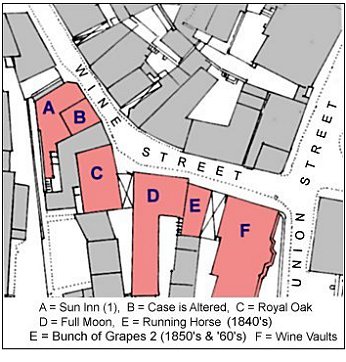 This
pub was
originally known
as the Queen's
Head, changing
to the Queens
Arms around 1840
and had been
trading at least
since 1766. By
1866, after the
demise of the
beerhouse named
the
Royal Oak,
it was known as
the Royal Oak or
the Royal Oak
Inn. During the
late 20th
century it was
renamed the Hole
In The Wall and
became a
restaurant
called the Green
Room circa 2005.
This
pub was
originally known
as the Queen's
Head, changing
to the Queens
Arms around 1840
and had been
trading at least
since 1766. By
1866, after the
demise of the
beerhouse named
the
Royal Oak,
it was known as
the Royal Oak or
the Royal Oak
Inn. During the
late 20th
century it was
renamed the Hole
In The Wall and
became a
restaurant
called the Green
Room circa 2005.
It is shown as
'C' on the map
at left.
A very old
building still
retaining its
16th century
cellar and
much-repeated,
yet apocryphal,
stories of
tunnels linking
the cellars to
the crypt of St
John's church. A
couple of months
ago I was
chatting to my
friend Bob
Banfield, the
Verger of St
John's, as he
was showing me
around the crypt
and he mentioned
the tunnels.
Then just this
week I was
chatting to a
guy in the Pall
who mentioned
the tunnels, and
he turned out to
be one of the
Hole in the
Wall's last
landlords.
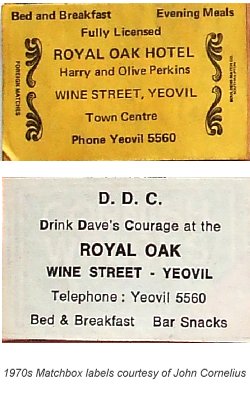 Strangely, no
one has
discovered the
tunnels recently
- there's a
surprise since
they have never
existed. Think
about it - the
crypt is only
partially set
into the ground
and has fairly
large windows.
There were also
graves six feet
deep close to
the church wall.
Then stand
outside the Pall
and look up
Silver Street
towards today's
Green Room and
you'll realise
that had there
been any tunnel
it would have
had a slope of
something like
thirty degrees
and at the
church end would
have required a
staircase. Who
in their right
mind would dig a
tunnel like that
and what on
earth would they
use it for?
Strangely, no
one has
discovered the
tunnels recently
- there's a
surprise since
they have never
existed. Think
about it - the
crypt is only
partially set
into the ground
and has fairly
large windows.
There were also
graves six feet
deep close to
the church wall.
Then stand
outside the Pall
and look up
Silver Street
towards today's
Green Room and
you'll realise
that had there
been any tunnel
it would have
had a slope of
something like
thirty degrees
and at the
church end would
have required a
staircase. Who
in their right
mind would dig a
tunnel like that
and what on
earth would they
use it for?
Wine Street
(which
originally
comprised of
both today's
Wine Street
and lower
Union Street
as far as
South
Street) had been
called Grope
Lane and is even
mentioned in the
Woborn Muniments
of 1431. The
name Grope Lane
probably refers
to
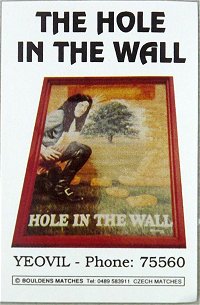 nothing more
salacious than
having to grope,
or feel, one's
way along in the
dark, narrow
lane.
nothing more
salacious than
having to grope,
or feel, one's
way along in the
dark, narrow
lane.
It only changed to Wine Street between 1813 and 1831, probably around the time Peter Daniell built Union Street. It is thought that the change to the new street name was in reference to the Wine Vaults, at the time simply the retail outlet and store of a wine merchant and not the pub we are used to seeing today. In 1879, 1880 and 1882 the Post Office Directory noted that Mr Dalwood ran a carrier service to Stoke from the Royal Oak every Friday.
The following description is from the Somerset Historic Environment Record
"Inn. Middle C18. Cut and squared local stone, now colourwashed; with undulating plain clay tiled roof, the North end gable having a coping - to the South a large brick chimney stack. Set in an angle of the road, with infill wing at right angles Eastwards. East elevation has a modern door and casement window under a timber fascia - return a modern doorway with fanlight over, and right a 12-pane sash window in plain opening from which the bottom casement glazing bars have been removed. East front first floor has, left, an 8-pane sash window set in an architrave, and then two 12-pane sashes in one architrave separated by a plain mullion: on the return a single 12-pane sash window in plain opening. Timber framed central dormer to main roof with 3-light casement window, probably a late C19 addition. The interior not seen."
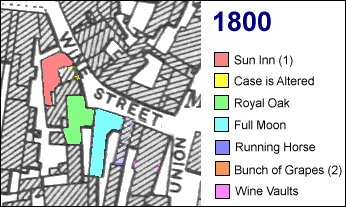 The
animation at
left shows the
development of
the Grope Lane /
Wine Street
premises from
1800 through
1880.
The
animation at
left shows the
development of
the Grope Lane /
Wine Street
premises from
1800 through
1880.
The Royal Oak operated throughout the period although, of course, was called the Queen's Arms until the 1850's.
|
Yeovilians remember...
Thanks
to
Geraldine
Locke
for the
following
information
"Mr
Clarence
Henry
Perkins
(It may
well be
Henry
Clarence,
mum and
I aren’t
sure!)
but he
was
known as
Harry,
was the
landlord.
He was
definitely
there in
1968 to
1971 but
the rest
we are
unsure.
They
moved
down
from the
Mendips
after
selling
their
farm,
whether
this was
1968 or
before
we are
not
sure,
and
again I
know I
was
taken
into the
upstairs
after I
was born
which
was 1971
and I
know
they had
moved to
Beer
Street
by the
time my
sister
was born
which
was
August
1973." |
![]()
George Leach, the first recorded licensee of the premises when known as the Queen's Arms, was born about 1806. He ran the pub with his wife, Sarah, and their five children and was listed in the 1841 census as the innkeeper at the Queen's Arms and was noted as such in Pigot's Directory of 1842. However by the time of the 1851 census George, now described as a glover, was living with his family in London Road (today's Sherborne Road).
The following licensee, Robert Tucker, was born about 1810 at Purleigh, Somerset (between Bristol and Chippenham) and in the 1851 census was listed as innkeeper and living at the Queen's Arms with his wife, Elizabeth, their three young daughters, his mother-in-law, Jane Foan, brother-in-law, sister-in-law, and no less than eight lodgers. Robert died in July 1853, aged about 43.
Interestingly the 1851 census shows that the small building sandwiched between the Queen's Arms / Royal Oak and the Case is Altered was an almshouse in which lived five (mostly) elderly women, all of whom were listed as 'inmates' in the census.
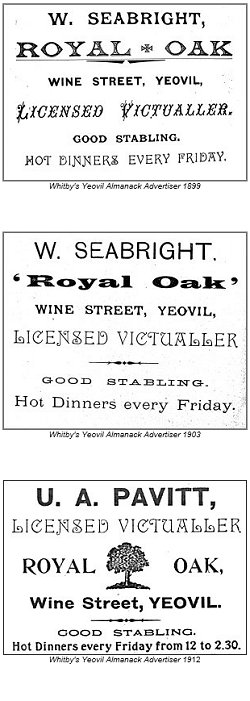 The 1861
census shows
that William
Brown, aged 41
and from North
Perrott, was
living at the
premises with
his
Crewkerne-born
wife, Elizabeth,
and their three
young children.
William's
occupation is
given a
victualler -
whether this was
supposed to be
licensed
victualler (ie
publican) or
plain victualler
(ie grocer) is
not clear and it
may be that at
this time the
premises lost
its license and
traded as a shop
and, when it
reopened as
licensed
premises (by
1866) was
re-named the
Royal Oak -
we'll probably
never know.
The 1861
census shows
that William
Brown, aged 41
and from North
Perrott, was
living at the
premises with
his
Crewkerne-born
wife, Elizabeth,
and their three
young children.
William's
occupation is
given a
victualler -
whether this was
supposed to be
licensed
victualler (ie
publican) or
plain victualler
(ie grocer) is
not clear and it
may be that at
this time the
premises lost
its license and
traded as a shop
and, when it
reopened as
licensed
premises (by
1866) was
re-named the
Royal Oak -
we'll probably
never know.
In any event Kelly's Directory of 1866 names the premises as the Royal Oak for the first time and lists Mrs Mary Chamberlain as the licensee. Mary, born in Yeovil around 1818, had been married to Matthew Chamberlain, a glove cutter and in 1861 they were living in Rake's Buildings on Reckleford with their two daughters; Emily aged 20 and 17-year old Albetina. Matthew died in April 1862 and by 1866 Kelly's Directory was listing Mary as the licensee of the newly-named Royal Oak. The 1871 census lists Mary as an innkeeper and 53-year old widow. Emily and Albetina had left home, but also living on the premises were an ostler (presumably working on the premises as well) and four lodgers - a costermonger, a glover, a domestic servant and the County Court Bailiff. Mary had left the Royal Oak by 1875 and died in the winter of 1876, aged about 58.
Kelly's Directory of 1875 listed William Seabright at the new licensee of the Royal Oak. William was born around 1844 at Lyndhurst, Hampshire, the son of agricultural labourer Charles Seabright and his wife, Sarah. William was also an agricultural labourer but he moved to Yeovil and married his Yeovil-born wife, Emily, in 1866. They and had a son, William, and a daughter, Albertena. By the time of the 1871 census the family were living at the Somerset Inn in Preston Road, where William was the licensee. By 1875, however, Kelly's Directory was listing him as the licensee of the Royal Oak where he was to remain the licensee until at least 1903. Sadly, however, Emily committed suicide in 1885 (see newspaper report below). The 1911 census listed William as a retired inn keeper living with his new wife, Mary, at 131 Gold Croft.
Following William Seabright as licensee, Urban Albert Pavitt was born about 1871 in Barwick, near Yeovil, the son of waiter William Anstice Pavitt and his wife, Sophia. The 1901 census found Urban living in his older brother George's pub in Canning Town, West Ham, London. George and his wife, Nellie, were both listed as licensed victuallers and Urban, aged 29 and still unmarried, was described as the bar manager. It must have been a fair sized establishment as there were no less than six live-in barmaids and a cook. By 1904 Urban was living in Yeovil and in April he married Eliza. In 1907 he was listed in the Yeovil Directory as the licensee of the Royal Oak, a listing repeated in the 1912 Whitby's Yeovil Almanack Advertiser (where he was also listed as a carrier) although Urban Albert Pavitt died in July 1912, aged about 41.
William Ricketts was the next licensee but there were at least four men named William Ricketts in Yeovil at the time and it's not really possible to tell which was which. It is likely that the William Ricketts of the Royal Oak was either the William Ricketts who ran the Anchor Inn in Vicarage Street or William Ricketts of the Duke of Wellington in Sherborne Road.
gallery

A report of the annual dinner, with catering by William Seabright, of the Yeovil Volunteer Band of the 16th Somerset Rifle Volunteers at the Royal Oak as reported in the 31 January 1873 edition of the Western Gazette.
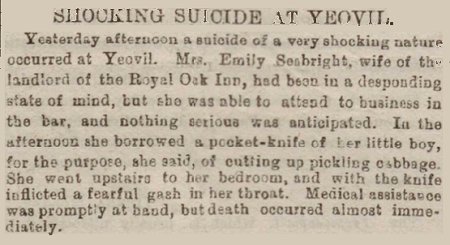
The report on the suicide of Emily Seabright at the Royal Oak, from the Exeter & Plymouth Gazette's edition of 22 September 1885.
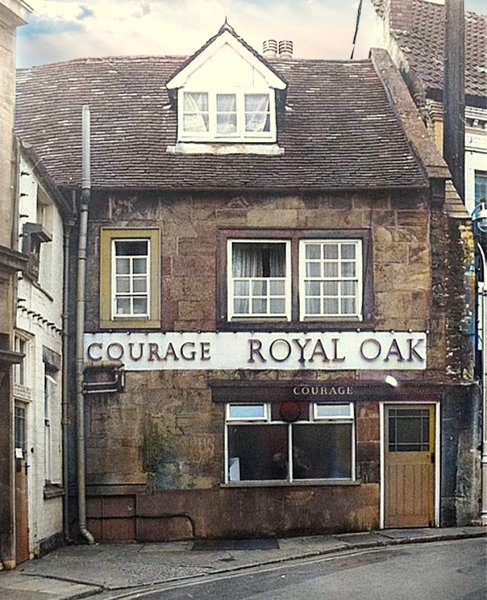
This colourised photograph of the Royal Oak dates to the 1960s.
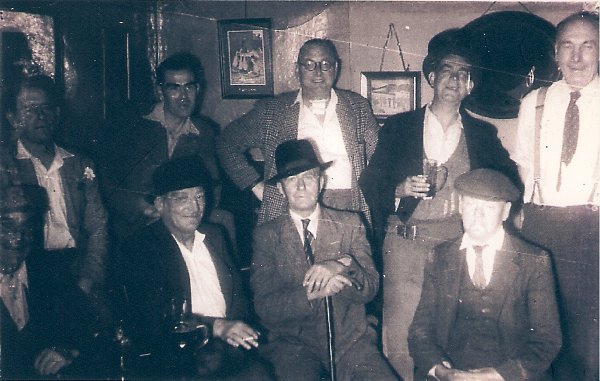
Courtesy of
Derek Phillips
Regulars in the bar of the Royal Oak, c1952. Standing at far right is landlord George 'Jimmy' Neill - but can anyone put a name to any of the other faces?
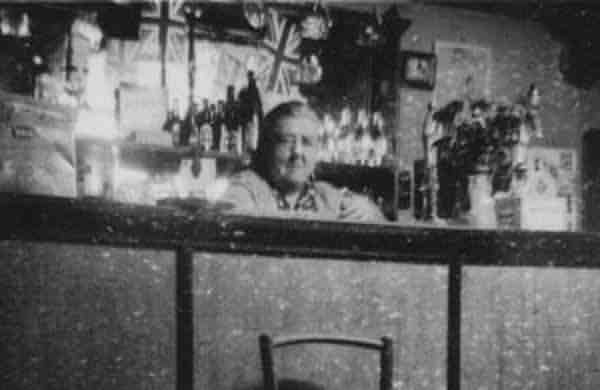
Courtesy of
Derek Phillips
Virginia Neill - landlady of the Royal Oak - photographed around 1952.
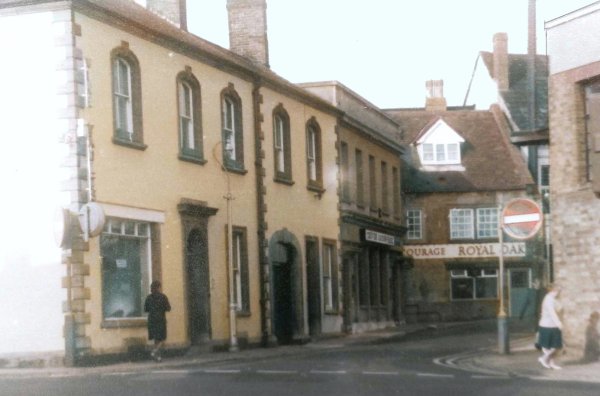
Wine Street, seen from Peter Street in the 1960s. Originally (before Union Street was constructed in the 1830s), Wine Street continued to the left as far as South Street.
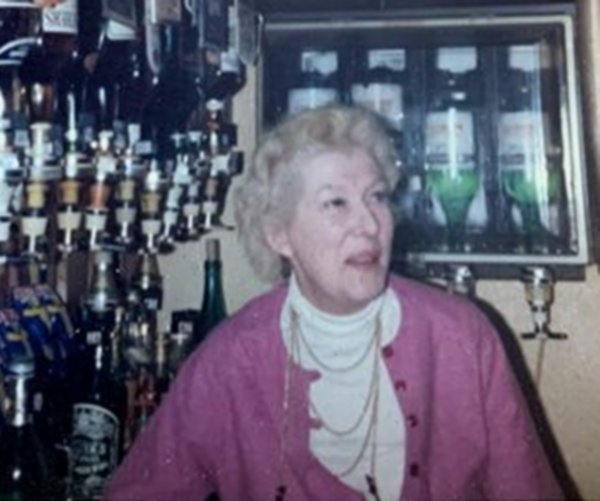
Courtesy of
Susanne Sodo
Liz behind the bar when it was the Hole in the Wall.
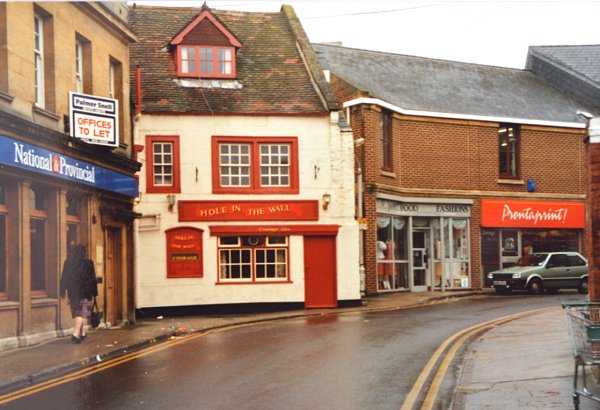
Courtesy of
Chris Rendell
The Hole in the Wall photographed in 1989.
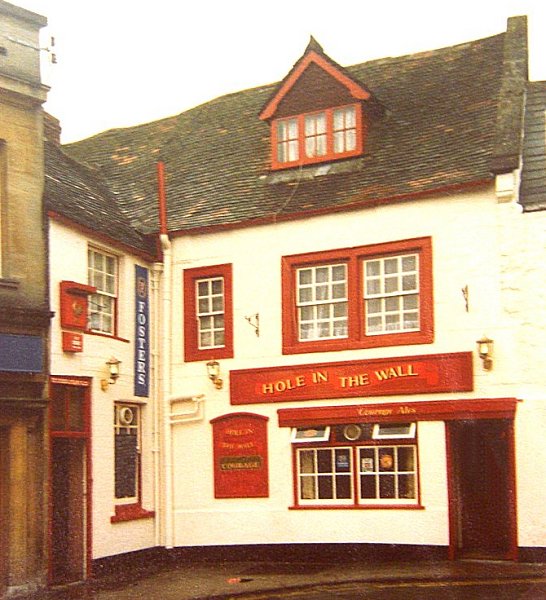
In its guise as the Hole in the Wall.
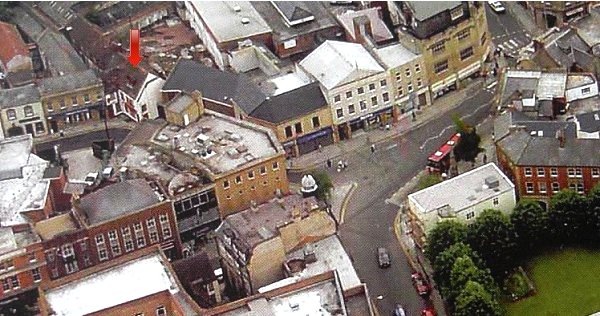
An aerial photograph of the Borough in 1988. The Royal Oak in its guise as the Hole in the Wall (arrowed) stands on the bend in Wine Street. The Borough (technically still High Street) is right of centre with Middle Street running to bottom left and the entrance to King George Street, before pedestrianisation, at top right. St John's churchyard, still known locally as 'The Beach' is at bottom right of the photo.
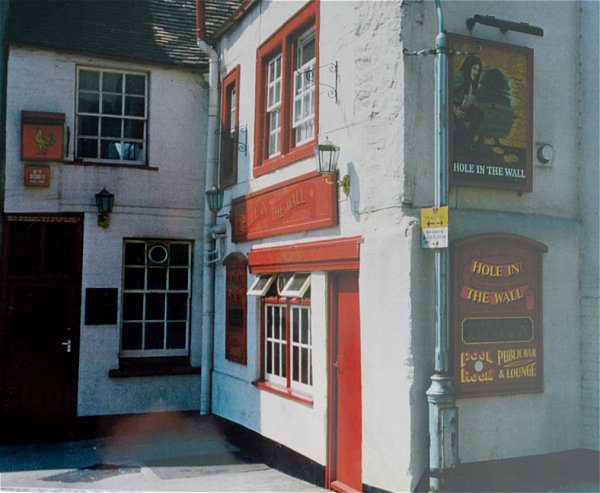
Courtesy of Bill and Audrey Robertson
Photographed in the 1990s.
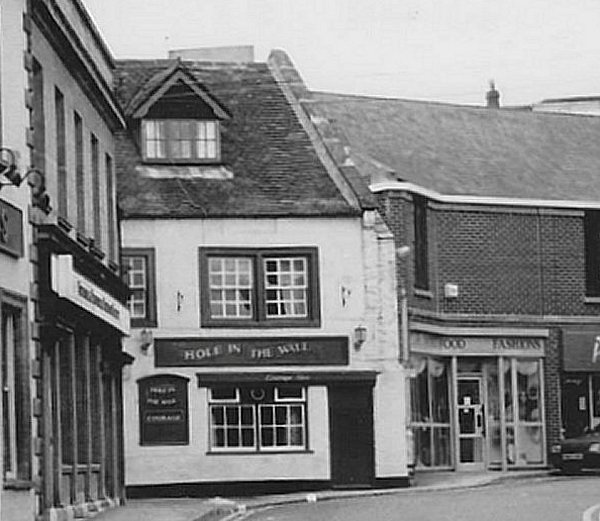
Photograph by
Trevor Hussey,
courtesy of Mrs
Anne Hussey
Photographed in 1990.
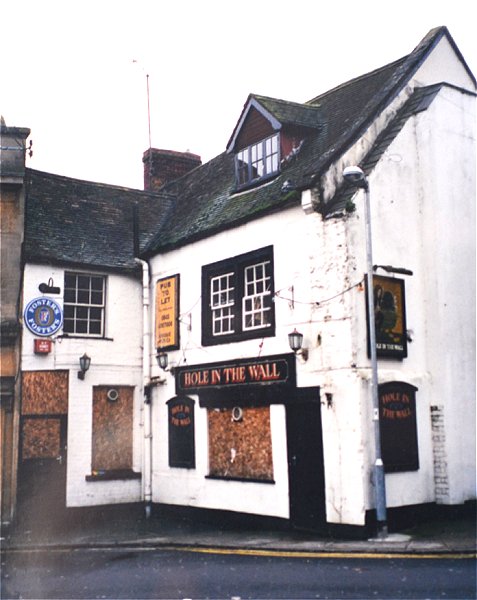
Courtesy of
Vivien and John
Cornelius
Closed, boarded up and for sale in 2002.
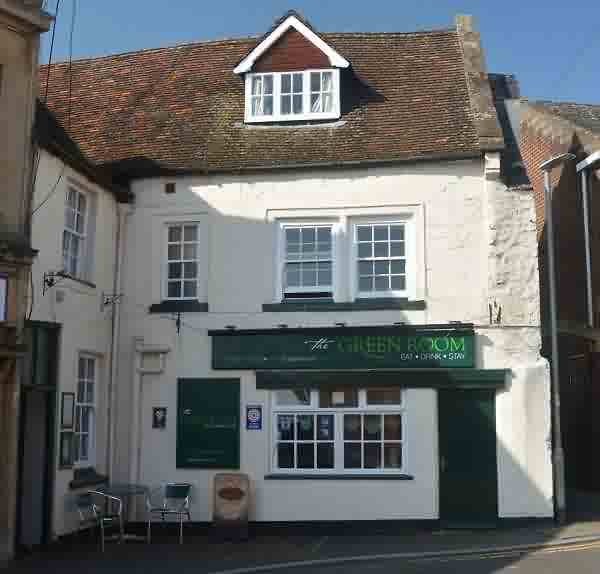
This photograph
features in my
book "Yeovil
In 50 Buildings"
In its guise as the Green Room. This photograph 2017.
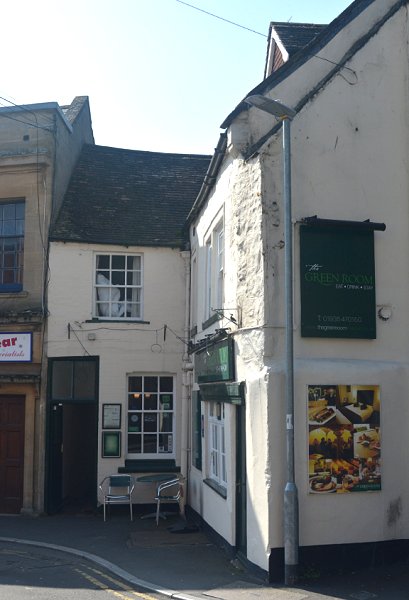
This photograph
features in my
book "Yeovil
In 50 Buildings"
The quaint return of the building actually seems older than the main elevation even though it is much later. Photographed in 2017.
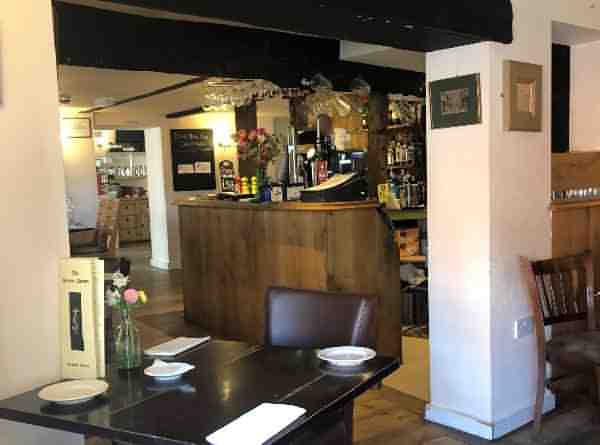
The bar area of the Green Room. Photographed in 2019.
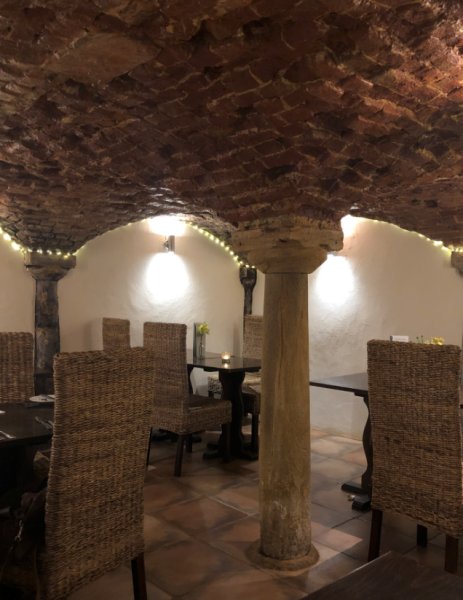
As part of the Green Room restaurant, the original sixteenth century columns supporting the vaulted cellar ceiling remain. Photographed in 2022.
licensees
Licensees as
Queen's Head
1766 – Licensee
not named (Land
Tax Returns 1766
- SRO Q/REI)
Recorded as
Queen's Head
1766 – Licensee
not named (Poor
Rate Book)
listed as the
Queen's Head
1785 – William
Eglen (Land Tax
Returns 1766 -
SRO Q/REI)
Recorded as
Queen's Head
1785 – Mr Dunn,
Proprietor,
William Eglen,
Occupier (Land
Tax Returns 1766
- SRO Q/REI)
Recorded as
Queen's Head
1792 – Mr
England,
Occupier (Land
Tax Redemption
Register)
Licensees as
Queen's Arms
1841 – George
Leach –
Innkeeper (1841
census) pub name
not recorded
1842 – George
Leach (Pigot’s
1842-4
Directory)
listed as Queens
Arms
1847 – W Bide,
owner, Robert
Tucker, occupier
(Church Rate
Book)
1850 – Robert
Tucker – Beer
Retailer (Hunt &
Co 1850
Directory)
listed in Wine
Street
1851 – Robert
Tucker – Inn
Keeper (1851
census) pub name
not recorded
1852 – Robert
Tucker – Inn
Keeper (Slater’s
1852 Directory)
listed as
Queen's Arms
1861 – William
Brown –
Victualler (1861
census) pub not
named
Licensees as
Royal Oak
1866 – Mrs Mary
Chamberlain
(Kelly’s 1866
Directory)
listed as Royal
Oak, Wine Street
1871 – Mary
Chamberlain (53
year old widow)
– Innkeeper
(1871 census)
1872 – William
Seabright -
Temporary
license (Borough
Petty Sessions,
February)
1872 – Mary
Chamberlain -
License transfer
(Borough Petty
Sessions, March)
1872 – W
Sebright -
License
transferred
(Borough Petty
Sessions, March)
William
Seabright moved
from the
Somerset Inn
1875 – William
Seabright – Beer
Retailer
(Kelly’s 1875
Directory)
listed as Wine
Street
1881 – William
Seabright –
Publican (1881
census) listed
as Royal Oak.
1889 – William
Seabright – Beer
Retailer
(Kelly’s 1889
Directory)
listed as Royal
Oak
1891 – William
Sebright –
Licensed
Victualler (1891
census) listed
as Royal Oak
1895 – William
Seabright
(Kelly’s 1895
Directory)
listed as Royal
Oak PH
1892 – William
Seabright -
fined 10s for
selling 30°
under-proof
whisky (Petty
Sessions, June)
1901 – William
Seabright – Inn
Keeper (1901
census) listed
as Royal Oak at
10 Wine Street
1902 – William
Seabright
(Kelly’s 1902
Directory)
listed as Royal
Oak
1903 – W
Seabright
(Whitby's Yeovil
Almanack
Advertiser 1903)
listed as Royal
Oak
1907 – UA Pavitt
(1907 Yeovil
Directory)
1911 – Urban
Albert Pavitt –
Licensed
Victualler (1911
census) listed
as Royal Oak
1912 – Urban
Albert Pavitt
(Whitby's 1912
Yeovil Almanack
Advertiser)
1914 – William
Ricketts
(Kelly’s 1914
Directory)
listed as Royal
Oak
1915 – William
Augustus
Ricketts
(Whitby's 1915
Yeovil Almanack
Advertiser)
1919 – George
Hardy (Kelly’s
1919 Directory)
listed as Royal
Oak
1923 – George
Hardy (Kelly’s
1923 Directory)
listed as Royal
Oak PH
1935 – George PA
Hardy (Kelly’s
1935 Directory)
1936 – PA Hardy
(1936 Yeovil
Directory)
listed as Royal
Oak
1938 – PA Hardy
(1938 Yeovil
Directory)
listed as Royal
Oak
1939 – George
Hardy (Kelly’s
1939 Directory)
listed as Royal
Oak PH
1945 Sept -
George and
Virginia Neall
1947 – S Neill
(1947 Yeovil
Directory)
listed as Royal
Oak
1949 – S Neill
(Kelly’s 1949
Directory)
listed as Royal
Oak
1951 – F Neill
(1951 Yeovil
Directory)
listed as Royal
Oak
1954 – F Neill
(1954 Yeovil
Directory)
listed as Royal
Oak
1957 – EJ
Barnicott (1957
Yeovil
Directory)
listed as Royal
Oak
1960 – Licensee
not named (1960
Yeovil
Directory)
listed as Royal
Oak
1964 – Albert E
Williams (Foord's
1964 Directory)
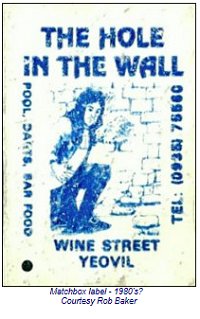 1965 – Licensee
not named (1965
Yeovil
Directory)
1965 – Licensee
not named (1965
Yeovil
Directory)
listed as Royal
Oak
1968 – Licensee
not named
(Kelly’s 1968
Directory)
listed as Royal
Oak Inn
1968-71 –
Clarence Henry
"Harry" Perkins
(from
correspondence
above)
1969 – Licensee
not named
(Kelly’s 1969
Directory)
listed as Royal
Oak Inn
1970 – Licensee
not named
(Kelly’s 1970
Directory)
listed as Royal
Oak Inn
1971 – Licensee
not named
(Kelly’s 1971
Directory)
listed as Royal
Oak Inn
1972 – Licensee
not named
(Kelly’s 1972
Directory)
listed as Royal
Oak Inn
1973 – Licensee
not named
(Kelly’s 1973
Directory)
listed as Royal
Oak Inn
1974 – Licensee
not named (1974
Yeovil
Directory)
listed as Royal
Oak Inn
1974 – DAK Hill
(Kelly's 1974
Directory)